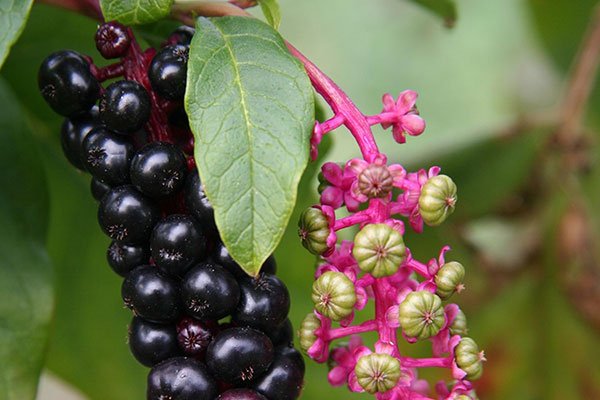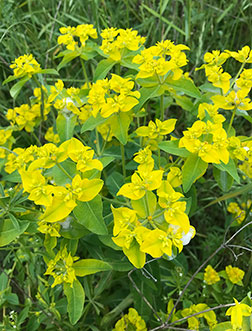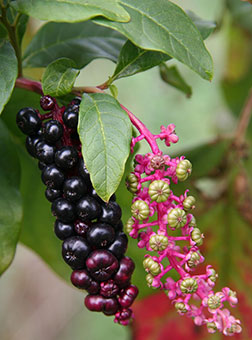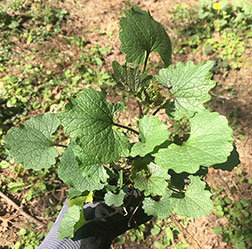Gardening & Environment

- Divide and conquer plants to keep them healthy and productive
- Watch out for this terrible trio of weeds in the Tualatin Watershed!
- 2020 Garlic mustard management season
Divide and conquer plants to keep them healthy and productive
by Weston Miller, OSU Extension Service | Department of Horticulture; and Kym Pokorny, OSU Public Service Communications Specialist
While you’re weeding and seeding and planting and pruning, there’s one more thing to put on your plate: dividing.
“Dividing is a matter of digging up plants, prying them apart with your hands, spades, knives, or an ax and replanting them in new holes,” said Weston Miller, a horticulturist for Oregon State University’s Extension Service. As perennials grow from the crown and the clumps get larger, plants decline in vigor and have fewer flowers. If you wait too long to divide, flowering can stop altogether.

That’s not the only reason to take out the spade and start splitting up your prized plants. “I divide plants when I want more of them,” Miller said. “I’m looking outside and seeing some chives. I’ll hack those into quarters. I divide things like yarrow a lot because I want to populate large areas.”
Gardeners love to dig and divide plants and share them with friends and neighbors. However, with new threats in Oregon from invasive species like Japanese beetles and the so-called “crazy snake worm,” it is no longer recommended to move plants or soil from one location to another. Also, OSU does not recommend plant swaps or sales based on dug-up plants at this time. Refer to guidelines for Best Management Practices for plant sales.
How many more plants you end up with depends on the size and vigor of the original plant. Hosta, grasses, and daylilies can produce six or more, while hollyhock and coral bells may only yield three. Be sure to pay attention to how many growing points there are and leave at least two per clump when you cut plants apart.
As a general rule, Miller said, divide summer- and fall-blooming plants in spring and spring-blooming plants after they’ve bloomed or in the fall. Don’t cut apart a plant when it’s blooming.
“You’ll know your plant needs dividing if it’s dying in the middle or becoming lackadaisical,” he said. Even if a reference says to divide a plant every three years, there’s no need to do so if it’s growing well.
“One thing people don’t think to divide are culinary herbs such as sage, thyme, oregano and marjoram,“ Miller said.
“You’ll get much more supple growth and better culinary quality if they’re divided every couple of years.”
Miller’s advice on how to divide plants:
- Saturate soil where you plan to plant divisions a few days ahead of time.
- Prepare soil in the new planting area with organic matter and saturate again.
- Dig holes where you will plant divisions. Make them wide enough to accommodate the roots and a bit more. Dig deep enough so crown of divisions will be level with top of soil.
- If the soil is dry, water the plant a day or two before dividing it.
- Cut the plant down to six inches from the ground.
- Use a spading fork or sharp shovel to dig around the plant.
- Pry or dig out in one big chunk.
- Once on the surface, don’t allow root ball to dry out. If it’s a warm day, cover with a plastic sheet, cloth, or even plant clippings.
- Make sure there are growing portions in each division.
- For smaller plants or those with fibrous root systems like small ornamental grasses, pry apart the roots with your hands or saw through them with a serrated knife or weeding tool such as a Hori-Hori knife. Use a sharp spade, shovel, handsaw or ax for larger plants. With really tough roots, pry them apart with two spading forks placed back to back.
- Shake or hose off loose soil.
- Discard dead center of plant.
- Plant divisions with crowns even with soil line.
Read the full article online for Miller’s recommendations on which plants to divide in spring.

Watch out for this terrible trio of weeds in the Tualatin Watershed!
by Tyler Pedersen, Invasive Species Program Coordinator, TSWCD

This spring and summer we are asking all our Tualatin Watershed Weed Watchers to keep their eyes out for three invasive plant species that are becoming more prevalent in our area. Balfour’s balsam, oblong spurge, and pokeweed have begun their invasion, but it’s not too late to act! Currently these weeds are in the early detection phase and not as widespread as common weeds like blackberry and ivy. However, they remain a threat to our streams, forests, and gardens if left to spread.
If you intend on controlling these species yourself, please make sure to first report them so Tualatin Soil & Water Conservation District can track their distribution.
Balfour’s balsam
An annual herb that grows up to 3.5 feet tall and has smooth, succulent, reddish-green stems. Pink and white flowers appear from July-September and have a long, straight spur behind the petals. Leaves are oval and alternate with toothed sides. Beware of the oblong-shaped seedpods that eject seeds up to 20 feet from the plant when touched or agitated! This species likes to invade stream banks and areas with moist soil. Hand pulling works well to control this plant. It’s best to remove plants in the early summer when the ground is moist, before they flower and go to seed in mid-summer. Throw plants away in a garbage bag into the trash.
Oblong spurge

A perennial herb that grows up to 3 feet tall with numerous stems originating from a woody rootstalk. Yellow-green flowers grow in clusters above a whorl of leaves on the end of stems from March-August. Leaves are alternate and oblong or lance-shaped. Seeds are ejected from capsules when ripe and have a sticky coating that allows them to be picked up and moved to new locations. Oblong spurge likes to invade gardens, moist fields, and roadsides. Please wear gloves when handling this species! Its stems contain a milky sap that causes skin irritation and is toxic to animals and humans when ingested!
Single plants can be dug up and thrown away in the trash, but care must be taken to remove all the roots and avoid disturbing the soil too much. Herbicide treatment is most effective and efficient for larger infestations. The best time to treat is in May before plants go to seed. Check https://www.swcd.net/ in May for the oblong spurge Weed of the Month article for more information on this species!
Pokeweed
Growing up to 8 feet tall, pokeweed is a large perennial forb with smooth, hollow, reddish-purple stems. Clustered, pink flowers appear from May-October around pink stems and produce numerous dark purple berries. Leaves are alternate and egg-shaped with smooth edges. It commonly grows under power lines or fence lines where birds roost, and in gardens, roadsides, and fields. All parts of pokeweed are highly toxic! Wear gloves when handling this plant and do not ingest any part of it, including the berries!

Smaller single plants can be dug up and thrown away in the trash, but larger plants and infestations may need to be treated with herbicide because of the deep taproot. The best time to treat is in July while in bloom, before it sets seeds in the late summer.
If you think you’ve found any of these species, you can report them to the Invasive Species Hotline here. In Washington County, the Tualatin SWCD responds to these reports and can provide assistance with identification and control. If you can upload close up photos of the plant, this will help us confirm its identity.
If you would like to learn more about identifying and reporting priority weeds in the Tualatin Watershed and Washington County, we are offering a free online workshop through May 27. You can sign up here: Weed Watchers will take a quiz at the end of the workshop and receive Tualatin Weed Watchers Guide PDF along with other helpful resources!
2020 Garlic mustard management season
By West Multnomah Soil & Water Conservation District

Continuing management of Garlic mustard, a highly invasive species, is essential to maintaining the health of our waterways, forests, and properties. During the coronavirus pandemic, District staff will be working remotely to treat the highest priority Garlic mustard infestations while following strict social distancing guidelines. We are being very thoughtful about where we conduct field work at this time, and are prioritizing time-sensitive projects that we’ve committed to, which includes the control of garlic mustard in the most impacted areas.
Download and read Frequently Asked Questions to learn more about this year’s Garlic mustard treatment season.
Garlic mustard management in Portland
Garlic mustard was discovered in the West Hills of Portland in 2007 by residents around Forest Park, and since then several property owners, volunteer groups, and natural resource agencies have come together to combat this aggressive, noxious invasive plant. Regionally, garlic mustard extent is limited. Managed populations are found in the greater Portland Metro and Seattle areas, with only a few known occurrences elsewhere in these states.
Within western Multnomah County, garlic mustard population centers are located near Skyline (between Burnside and Newberry Roads) and SW Portland (particularly Council Crest and near Lewis and Clark College). West Multnomah Soil & Water Conservation District, and our partners, provide free landowner assistance in managing garlic mustard infestations.
Using environmentally-sound integrated pest management approaches, we have seen good progress in reducing populations and minimizing the spread of garlic mustard. Over 400 properties have been surveyed, and 150 property owners receive annual assistance with control. Currently, less than 30 acres are impacted at project sites/ But your help is needed in finding and managing additional unknown patches.
How can you help
- Fill out a Permission to Access form to have your property surveyed by our staff.
- Take a weed watchers class (Visit the Weed Watcher page and sign-up when classes become available).
- Contact our Invasive Species Program Coordinator Michelle Delepine at (503) 238-4775, ext. 115 or michelle@wmswcd.org for more information about the Garlic Mustard Program.





